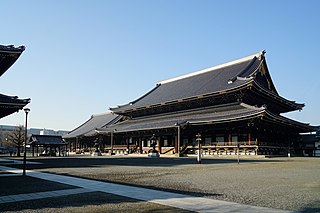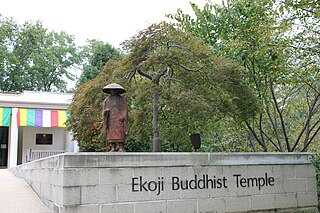
A bishop is an ordained clergy member who is entrusted with a position of authority and oversight in a religious institution.

Jōdo Shinshū, also known as Shin Buddhism or True Pure Land Buddhism, is a school of Pure Land Buddhism. It was founded by the former Tendai Japanese monk Shinran.

Rennyo was the 8th Monshu of the Hongan-ji Temple of the Jōdo Shinshū sect of Buddhism, and descendant of founder Shinran. Jodo Shinshu Buddhists often referred to as the restorer of the sect. He was also known as Shinshō-in (信証院), and posthumously Etō Daishi (慧灯大師). During the conflict of the Ōnin War and the subsequent warfare that spread throughout Japan, Rennyo was able to unite most of the disparate factions of the Jodo Shinshu sect under the Hongan-ji, reform existing liturgy and practices, and broaden support among different classes of society. Through Rennyo's efforts, Jodo Shinshu grew to become the largest, most influential Buddhist sect in Japan.

Hongan-ji, also archaically romanized as Hongwanji, is the collective name of the largest school of Jōdo Shinshū Buddhism. 'Hongan-ji' may also refer to any one of several actual temple buildings associated with the sect. Nishi Honganji (西本願寺) and Higashi Honganji (東本願寺) are two major temples in Kyoto.
The Buddhist Churches of America is the United States branch of the Nishi Honganji subsect of Jōdo Shinshū Buddhism.

Tsukiji Hongan-ji (築地本願寺), sometimes archaically romanized Hongwan-ji, is a Jodo Shinshu Buddhist temple located in the Tsukiji district of Tokyo, Japan.

Higashi Hongan-ji (東本願寺), or, ″the Eastern Monastery of the Original Vow″, is one of two dominant sub-sects of Shin Buddhism in Japan and abroad, the other being Nishi Honganji. It is also the name of the head temple of the Ōtani-ha branch of Jōdo Shinshū in Kyoto, which was most recently constructed in 1895 after a fire burned down the previous temple. As with many sites in Kyoto, these two complexes have more casual names and are known affectionately in Kyoto as Onissan and Ohigashisan.

Nishi Hongan-ji (西本願寺) is a Jōdo Shinshū Buddhist temple in the Shimogyō ward of Kyoto, Japan. It serves as the head temple of the sub-sect Honganji-ha.
The Buddhist Women's Association (BWA) is the English name of the worldwide auxiliary lay organization of the Nishi Hongwanji-ha branch of Jodo Shinshu Buddhism. Its Japanese name is Fujinkai. Many Jodo Shinshu temples in Japan, mainland United States, Hawaii, South America, and Canada have BWA chapters. The honorary head of the worldwide BWA is, traditionally, always the spouse (o-urakata) of the current Nishi Hongwnaji-ha monshu ; at this time, this position is held by the Lady Noriko Ohtani.

Ekoji is a temple of the Jōdo Shinshū Hongwanji-ha Japanese Buddhist sect in Fairfax Station, Virginia, near Washington, D.C. It is a member of the Buddhist Churches of America, the oldest Buddhist organization in the mainland United States.

The Institute of Buddhist Studies is a Jodo Shinshu-affiliated seminary and graduate school, located in Berkeley, California. It is a member school of the Graduate Theological Union, also located in Berkeley. Its mission is to provide graduate level education in the entirety of the Buddhist tradition with specialization in Jodo Shinshu ministry and Buddhist chaplains. It is the sole seminary for ministers serving temples in the United States through the Buddhist Churches of America, the U.S. mainland branch district of the Nishi Hongwanji sect of Japanese Buddhism.

Takeko Kujō was a Japanese educator and poet. She was one of the founders of the Buddhist Women's Association.

The Honpa Hongwanji Mission of Hawaii is a district of the Nishi (West) Hongwanji branch of Jodo Shinshu Buddhism, a school of Mahayana Pure Land Buddhism.
The Monshu (門主), or keeper of the gate is a term sometimes used in Japanese Buddhism to denote the head of a monastery, as in the case of Jōdo-shū and Tendai Buddhism, but in the case of the Nishi Hongan-ji sub-sect of Jōdo Shinshū Buddhism, it refers to the spiritual leader of the sect, and direct descendant of its founder Shinran.
The Jodo Shinshu Buddhist Temples of Canada are a group of temples and fellowships that are affiliated with the Nishi Hongan-ji of Kyoto, Japan, the mother temple of the Jodo Shinshu sect of Buddhism.

Ōtani-ha is a Japanese Buddhist movement. It belongs to Jōdo Shinshū, also known as Shin Buddhism. The movement has approximately 5.5 million members.
Jodo Shinshu Hongwanji-ha, commonly called Honganji-ha, is a Japanese Buddhist organization. It is a sub-sect within Jodo Shinshu. Its head temple is Nishi Hongan-ji. It is the largest Jodo Shinshu sub-sect, the second largest being Otani-ha.
The Cleveland Buddhist Temple is a Pure Land community currently meeting at the Unitarian Universalist Congregation of Cleveland in Shaker Heights, Ohio. It traces its beginnings to 1944, and is at its current location since April, 2018. The current Supervising Minister is Rev. Ron Miyamura with the assistance of Tokudo Ministers. Cleveland Buddhist Temple is affiliated with the Buddhist Churches of America (BCA), which is part of the Nishi Hongwanji tradition headquartered in Kyoto, Japan

Marvin Harada is a Jōdo Shinshū Buddhist minister within the Buddhist Churches of America, and serves as its bishop since 1 April 2020. As bishop of BCA, he also serves as the superintendent of Hongwanji-ha's North American district.













